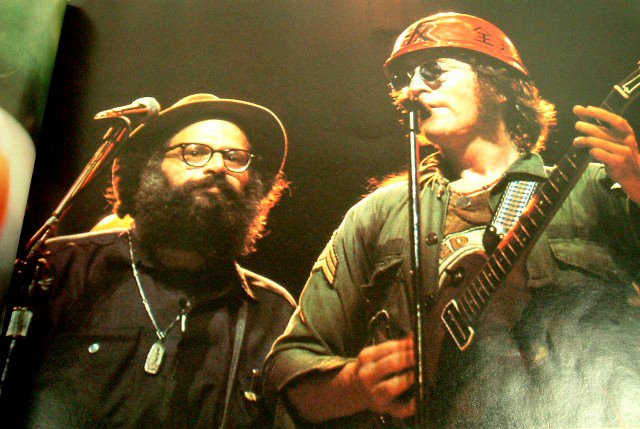“Shiny, shiny, shiny boots of leather
Whiplash girl child in the dark
Comes in bells, your servant, don’t forsake him
Strike, dear mistress, and cure his heart
Downy sins of streetlight fancies
Chase the costumes she shall wear
Ermine furs adorn the imperious
Severin, Severin awaits you there
I am tired, I am weary
I could sleep for a thousand years
A thousand dreams that would awake me
Different colors made of tears
Kiss the boot of shiny, shiny leather
Shiny leather in the dark
Tongue of thongs, the belt that does await you
Strike, dear mistress, and cure his heart
Severin, Severin, speak so slightly
Severin, down on your bended knee
Taste the whip, in love not given lightly
Taste the whip, now plead for me
I am tired, I am weary
I could sleep for a thousand years
A thousand dreams that would awake me
Different colors made of tears
Shiny, shiny, shiny boots of leather
Whiplash girl child in the dark
Severin, your servant comes in bells, please don’t forsake him
Strike, dear mistress, and cure his heart”
Lou Reed
Venus in Furs
The Velvet Underground & Nico (1967)
Fanny Pistor (in furs, with whip) and Sacher-Masoch
On 9 December 1869, Leopold Ritter von Sacher-Masoch and his mistress Baroness Fanny Pistor signed a contract making him her slave for a period of six months, with the stipulation that the Baroness wear furs as often as possible, especially when she was in a cruel mood. Sacher-Masoch took the alias of “Gregor”, a stereotypical male servant’s name, and assumed a disguise as the servant of the Baroness. The two traveled by train to Italy. As in Venus in Furs, he traveled in the third-class compartment, while she had a seat in first-class, arriving in Venice (Florence, in the novel), where they were not known, and would not arouse suspicion.
 The Titian painting Venus with a Mirror (1555), from which Severin gets the idea of “Venus in furs”
The Titian painting Venus with a Mirror (1555), from which Severin gets the idea of “Venus in furs”
 Sacher-Masoch is the great-great-uncle to the British singer and actress Marianne Faithfull on the side of her mother, the Viennese Baroness Eva Erisso
Sacher-Masoch is the great-great-uncle to the British singer and actress Marianne Faithfull on the side of her mother, the Viennese Baroness Eva Erisso
 The novel Venus in Furs was to be part of an epic series that Sacher-Masoch envisioned called Legacy of Cain. Venus in Furs was also part of Love, the first volume of the series. It was published in 1870
The novel Venus in Furs was to be part of an epic series that Sacher-Masoch envisioned called Legacy of Cain. Venus in Furs was also part of Love, the first volume of the series. It was published in 1870
The framing story concerns a man who dreams of speaking to Venus about love while she wears furs. The unnamed narrator tells his dreams to a friend, Severin, who tells him how to break him of his fascination with cruel women by reading a manuscript, Memoirs of a Suprasensual Man.
This manuscript tells of a man, Severin von Kusiemski, who is so infatuated with a woman, Wanda von Dunajew, that he asks to be her slave, and encourages her to treat him in progressively more degrading ways. At first Wanda does not understand or accede to the request, but after humouring Severin a bit she finds the advantages of the method to be interesting and enthusiastically embraces the idea, although at the same time she disdains Severin for allowing her to do so.
Severin describes his feelings during these experiences as suprasensuality. Severin and Wanda travel to Florence. Along the way, Severin takes the generic Russian servant’s name of “Gregor” and the role of Wanda’s servant. In Florence, Wanda treats him brutally as a servant, and recruits a trio of African women to dominate him.
The relationship arrives at a crisis when Wanda herself meets a man to whom she would like to submit, a Byronic hero known as Alexis Papadopolis. At the end of the book, Severin, humiliated by Wanda’s new lover, loses the desire to submit. He says of Wanda:
That woman, as nature has created her, and man at present is educating her, is man’s enemy. She can only be his slave or his despot, but never his companion. This she can become only when she has the same rights as he and is his equal in education and work.
The book inspired Venus in Fur, a 2010 play set in the modern day by David Ives, which had its Off-Broadway premiere at the Classic Stage Company in New York City starring Nina Arianda and Wes Bentley. In February 2012, a new Broadway production of this play premiered at the Lyceum Theatre starring Nina Arianda and Hugh Dancy. In late 2012, Roman Polanski directed a film adaptation of the play starring Emmanuelle Seigner and Mathieu Amalric.
 Still from Belle de Jour (Luis Buñuel, 1967)
Still from Belle de Jour (Luis Buñuel, 1967)
The name of Catherine Deneuve’s character, Séverine, is a femininization of the name of the male protagonist of Baron von Sacher-Masoch’s Venus in Furs, Severin. As the literary origin of the term masochism, Sacher-Masoch, along with his 1870 novel, no doubt presented an irresistible reference point for Joseph Kessel, the author of the 1928 novel Belle de Jour, on which the film is based.




















 English pop star and pianist Elton John performs at the Dodger Stadium in Los Angeles, October 1975
English pop star and pianist Elton John performs at the Dodger Stadium in Los Angeles, October 1975











